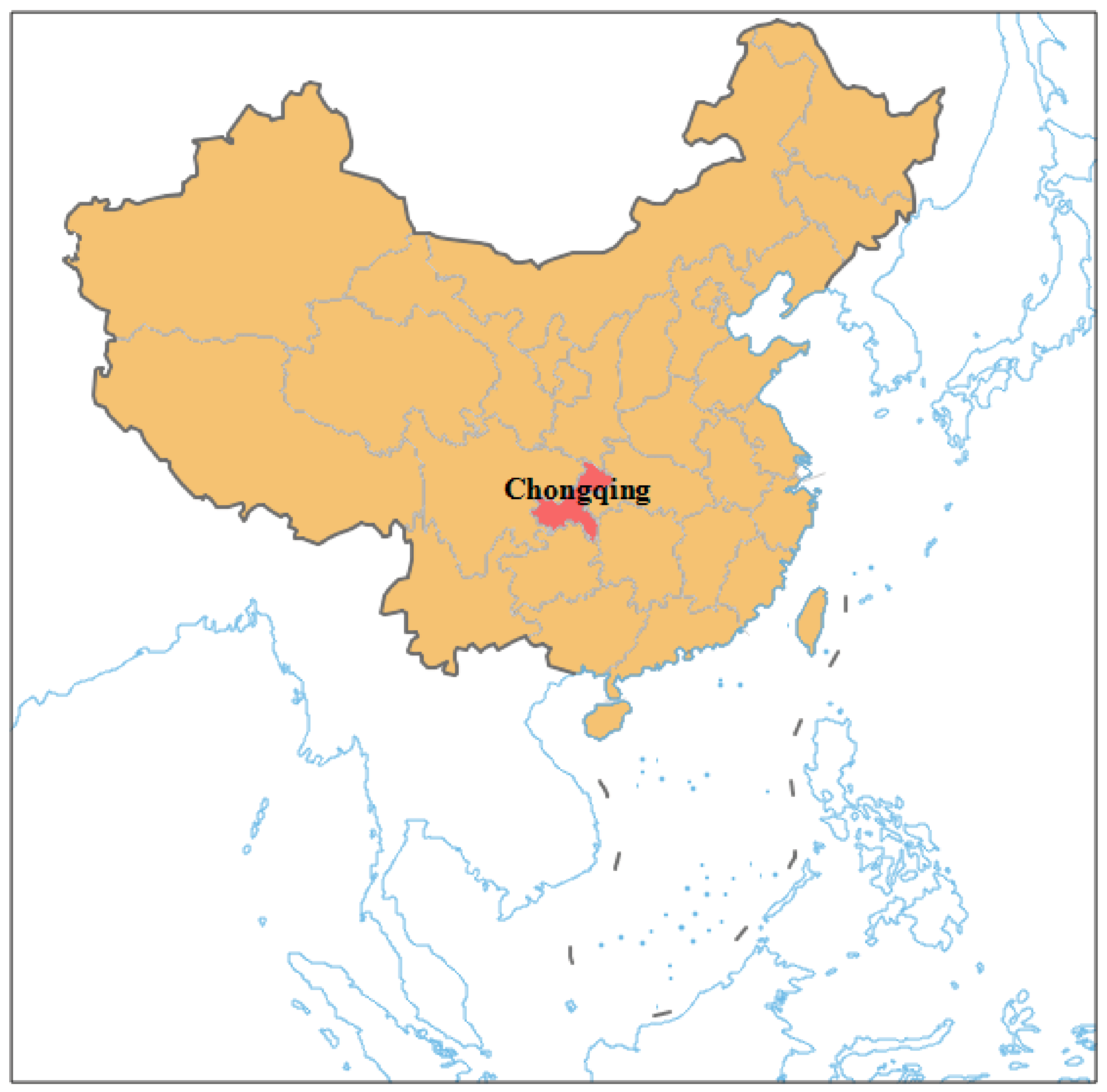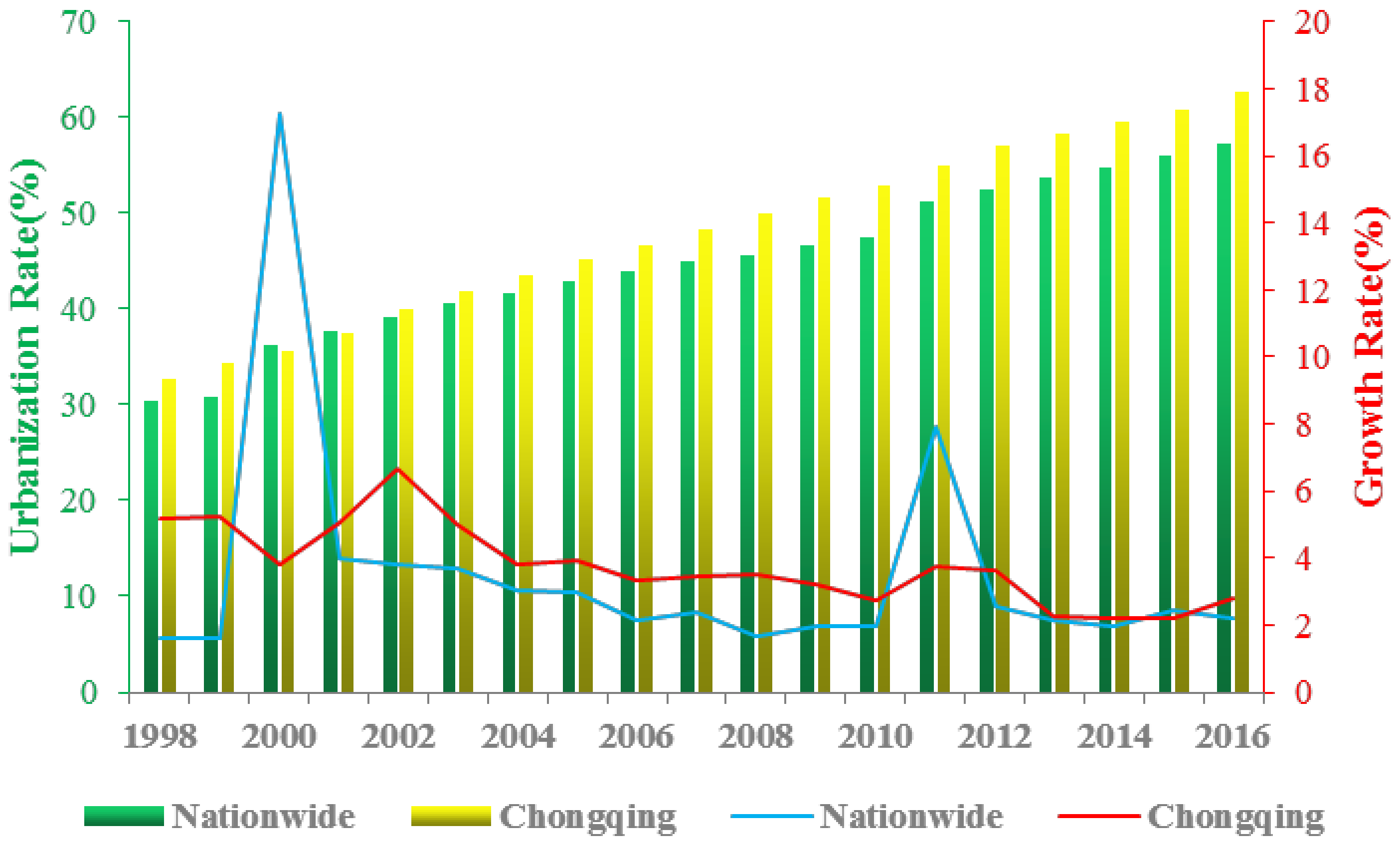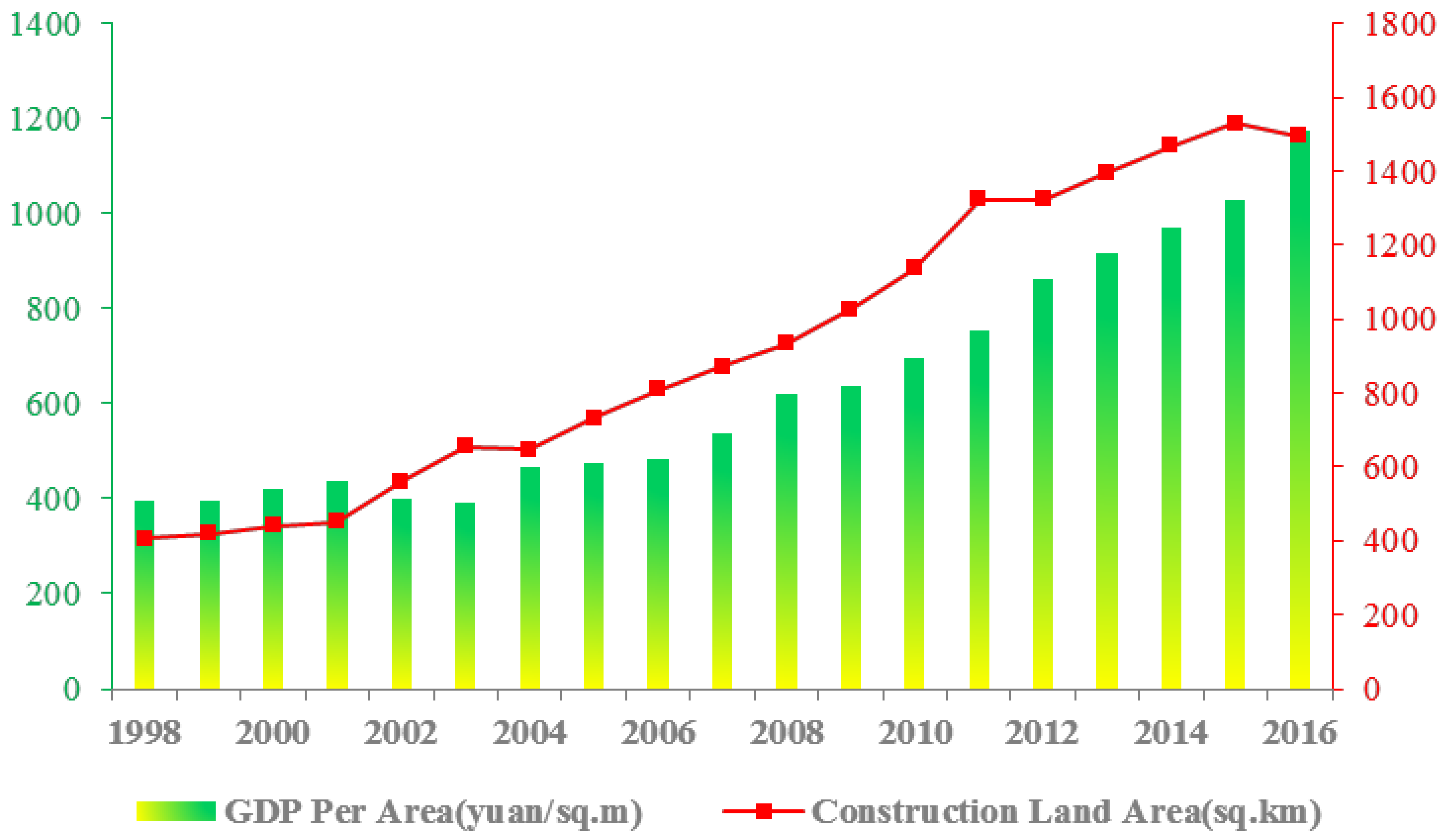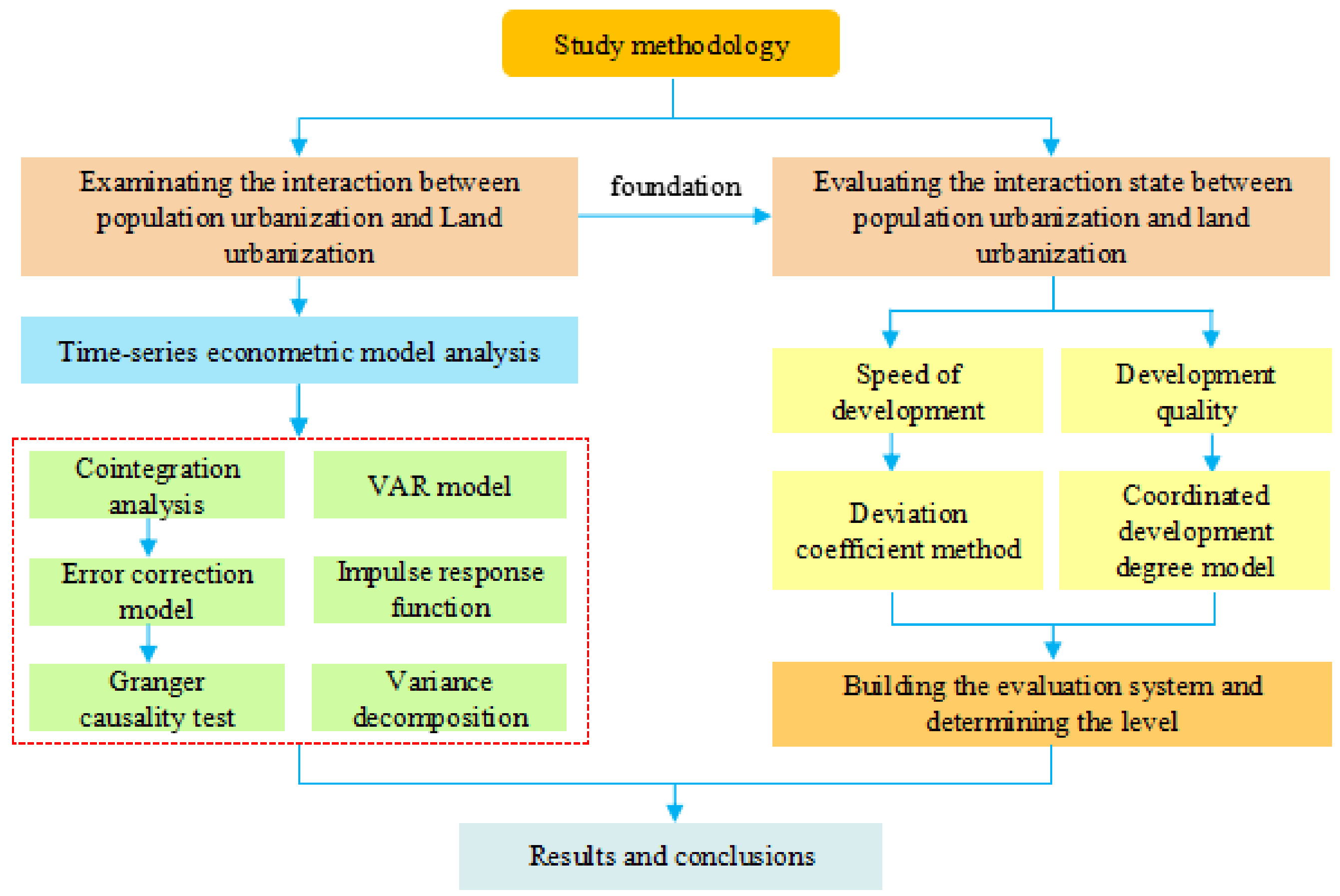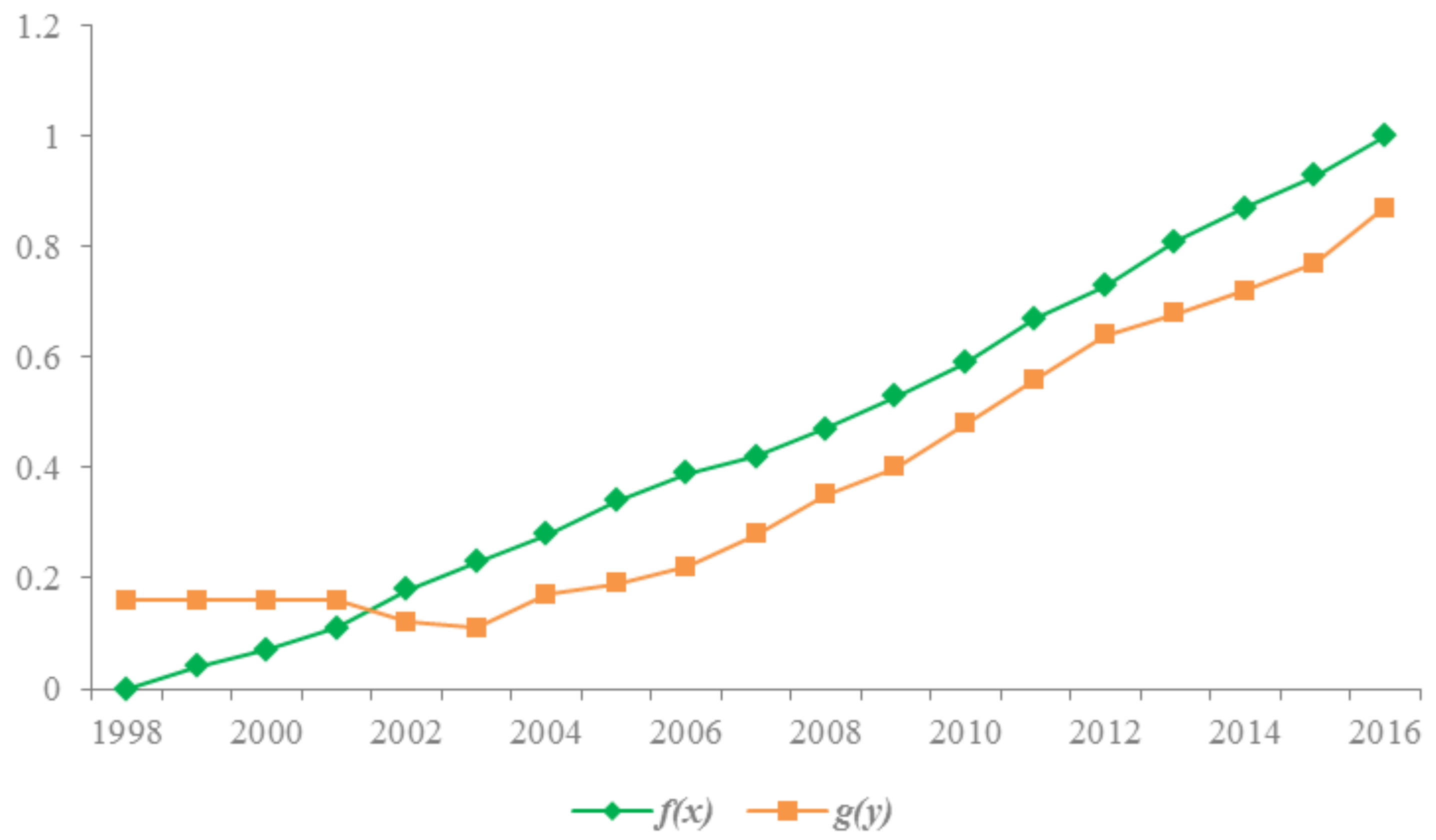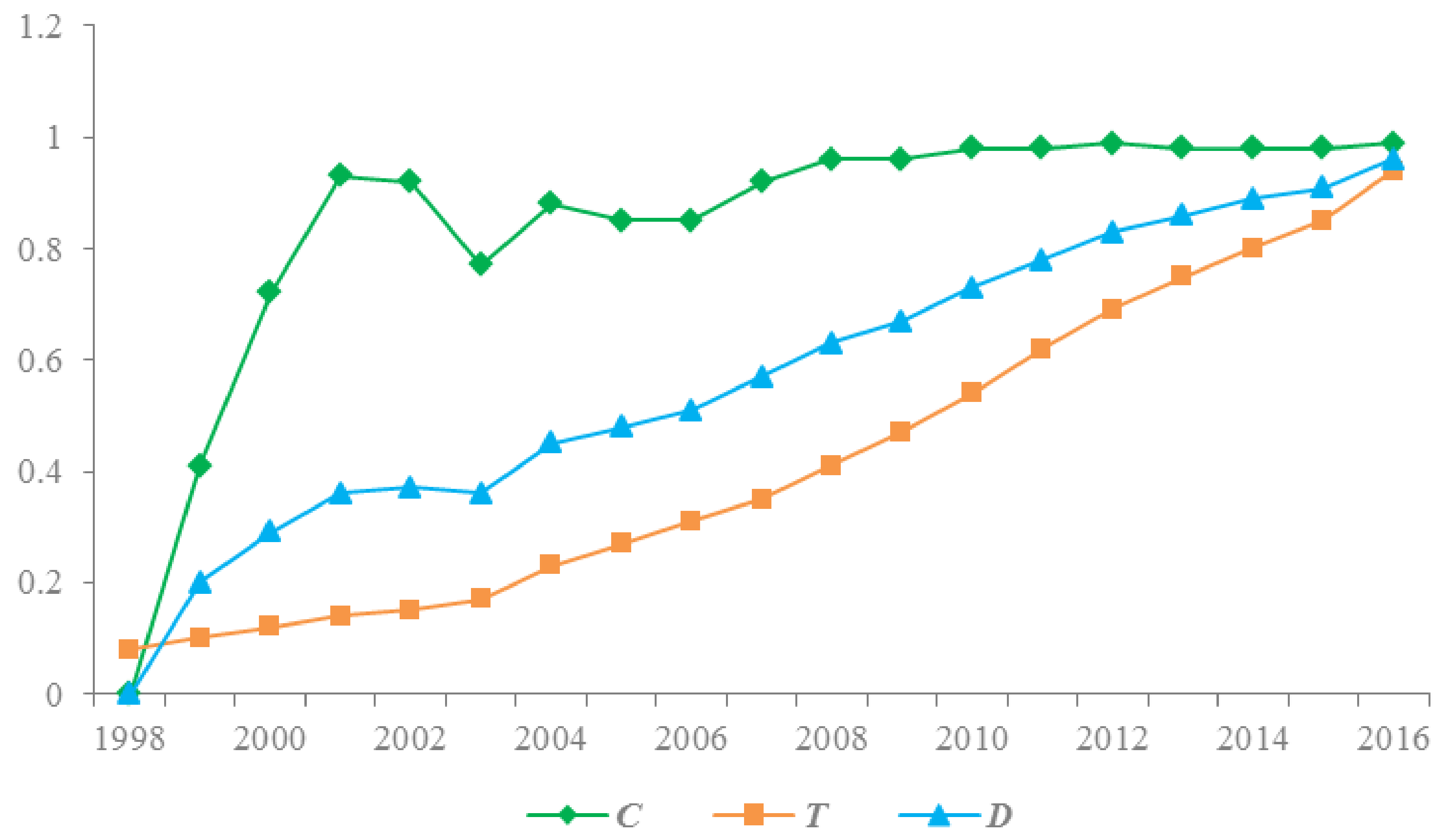1. Introduction
Urbanization has received increasing attention from governments worldwide, as it is a crucial prerequisite to global economic development, the eradication of extreme poverty, reversal of unsustainable growth, and protection of the natural environment [
1,
2,
3,
4,
5]. Since the reform and opening up, along with an acceleration in the process of industrialization, China’s urbanization has experienced a low and rapid development process. By the end of 2016, the permanent population in urban areas increased from 170 million in 1978 to 790 million, and the urbanization rate increased from 17.9% to 57.4%—an average annual increase of 1.04%; the number of cities increased from 193 to 659, and the number of established towns increased from 2173 to 20,883 [
6]. According to Northam’s three-stage theory of urbanization [
7], China is currently in a stage of rapid urbanization [
8]. The development of urbanization is the result of the flow and agglomeration of factors, of which the flow of population is the core [
9]. A large number of rural populations have flowed into the cities, which has brought sufficient labor for the industrialization of the city, and also increased the burden on urban construction land. The problem of extensive land use and low efficiency in the current urbanization drive in China is prominent [
10], and the contradiction between the growing demand for construction land and the scarcity of land resources will be the main contradiction to constrain the sustainable development of cities in the future [
11]. If the new era is to achieve a steady improvement in the level and quality of urbanization in China, which is a more optimized urbanization pattern [
12], and promote a win–win situation of urbanization and sustainability [
13], then a comprehensive and profound understanding of the interactive development relationship between population urbanization (PU) and land urbanization (LU) is needed.
Focusing on sustainable urbanization, scholars at home and abroad have undertaken much research. In the area of PU, research has mainly been focused on the driving factors of urbanization [
14,
15,
16], the mode of development [
17,
18], the difference of spatial distribution [
19,
20], and the influence of rapid urbanization on the environment [
21,
22,
23]. In the area of LU, it has mainly been focused on the study of the urban spatial expansion mechanism, including the driving factors of urban expansion [
24,
25,
26], the type of expansion [
27,
28], measurements, and policy regulation [
29,
30,
31], etc. For example, Li et al. [
32] constructed binary logistic regression and combined multitemporal images to study the drivers of urban expansion, where their studies showed that physical, socioeconomic, and neighborhood factors worked simultaneously, and that physical and neighborhood factors decreased with increasing urbanization, and socioeconomic factors increased with increasing urbanization. In addition, the influence of LU, which is the main form of urban sprawl on land ecological function and environment [
33,
34], on land use [
35,
36,
37] has also been widely studied by scholars. Therefore, the concept of sustainable urbanization [
4,
5,
38,
39,
40] has been put forward, and study into the relationship between PU and LU has become the focus of academia.
With regard to the study on PU and LU, scholars at home and abroad have mainly focused on the development coordination between PU and LU. In the comparison of the development speed [
41,
42,
43,
44] and the evaluation of coordination [
45,
46], remote sensing images, geographic information system technology, and coupled coordination analysis have been widely used in the research methods. For example, Min and Hu built a coordination degree model to evaluate the relationship between PU and LU in Hubei Province from 1998 to 2008, where the results showed that the development of population–land integration in Hubei Province was poor, and the degree of coordination showed a downward trend with significant fluctuation characteristics [
46]. Lin et al. used the data of 656 cities in China for the past ten years to construct the conceptual framework and calculation method for the number and speed of LU processes, and the results showed that LU was faster than PU [
43]. This was consistent with the conclusions reported in the National New Urbanization Plan (2014–2020) [
12], released by the State Council Development and Reform Commission.
To sum up, the research progress of PU and LU in comprehensive development, domestic and foreign scholars have achieved fruitful results, but the existing research content is still insufficient. This is mainly reflected in the research on the interactive development relationship between PU and LU. The two systems play a common role in promoting sustainable urbanization, and the interaction between them will have an effect of 1 + 1 > 2. The study of both should be carried out in a higher system dimension. We should not only pay attention to the speed and coordination of the development of the system, but also explore the mutual influence mechanism and the cause of the imbalance. Furthermore, the existing research has mainly focused on the whole national level, less at the provincial level, especially the provinces or cities in Western China.
Chongqing is located in Southwest China (
Figure 1), and is the youngest municipality in China. As a typical mountain city, the mountainous area of Chongqing’s main urban area is 2250 km
2, accounting for 41.09%; the hilly area is 2739 km
2, accounting for 50.03%; flatland area is 368 km
2, accounting for only 6.7%. Furthermore, under the rigid constraints of the country’s three basic systems (land in the cities is owned by the state and land in the rural area is owned by rural collective; land-use regulation system; land annual planning system), Chongqing’s construction land and agricultural land are particularly valuable. Based on the phenomenon of the prominent characteristics of urban–rural dual structure and the coexistence of “big cities and large rural areas”, the state set up the pilot area of integrated urban and rural comprehensive reform in 2007, and actively supported the special reform in Chongqing. With an important strategic position, Chongqing has gradually emerged as a distinctive “Chongqing model” under the backdrop of more people and less land. In terms of land use, the “Land Ticket Model” (2008) was adopted to reclamation idle construction land in rural areas into arable land and generated land indicators for urban construction [
47]. As of May 2016, 118 km
2 of land has been traded since the implementation of the “Land Ticket System”, which increased the supply of land to Chongqing by 14% each year, fundamentally solving the problem of insufficient urban construction land. In order to promote PU, Chongqing has given priority to the reform of household registration (2010) and gradually relaxed the restriction of rural population to settle in cities. Based on the difference of regional economic development level, resource endowment, and population carrying capacity, Chongqing divided the city into urban functional core area, urban functional expansion area, urban development new zone, northeast Chongqing ecological conservation development zone, southeast Chongqing ecological protection development area, five functional areas in 2013, for differential development of various functional areas to promote the development and construction of Chongqing metropolitan area. The unique development model promoted rapid economic growth in Chongqing. From 2002 onwards, Chongqing’s GDP growth has remained above 10%. The urban development model of Chongqing has aroused the attention of more and more scholars [
48,
49]. This paper used Chongqing as an example to analyze the interaction between PU and LU on the basis of analyzing the progress of urbanization, since its direct jurisdiction. It further analyzed and evaluated the interactive relationship between the two from the aspects of development speed and quality coordination. Corresponding policy suggestions were put forward for the coordinated development of population and land in the process of the sustainable urbanization of Chongqing.
The rest of the paper is organized as follows.
Section 2 is the definition of the basic concept and the construction of the theoretical model of the PU and LU interactive relationship.
Section 3 introduces the present situation of the research area first, then introduces the research methods, variable selection, and the data sources of empirical research.
Section 4 shows the results of the time series econometric model and interactive state evaluation; and
Section 5 is the discussion and analysis of the research results.
Section 6 introduces the research conclusions of this paper, puts forward the corresponding policy suggestion, and points out the next challenge and the brief thought of further research.
6. Conclusions and Policy Implications
6.1. Conclusions
This paper used Chongqing as an example, constructed an econometric model of time series to study the interaction between PU and LU in Chongqing and used the coordinated development degree model to analyze and appraise the interactive relationship between the development speed and the quality coordination. The following conclusions can be made:
- (1)
The horizontal comparison showed that the development level of urbanization in Chongqing was relatively insufficient, and the structure of land use irrational. The development of urbanization in Chongqing has been relatively rapid, but the current level of urbanization is still insufficient when compared with other municipalities. The proportion of urban population is small; the level of real urbanization is low, and there is a big gap between the urbanization rate of household registration population and the urbanization rate of resident population. The phenomenon of population outflow during the process of urban development is more serious, but there has been a gradual easing trend in recent years. In terms of urban land structure, the prominent problem is that industrial land accounts for a relatively large proportion, and land used for public management and facilities, as well as commercial service facilities, is obviously inadequate, which also leads to the weak capacity of Chongqing to absorb the labor force.
- (2)
There is a long-term cointegration relationship between PU and LU. PU is the Granger cause of LU, and population agglomeration contributes significantly to the development of urbanization as urban development models that rely on land expansion do not apply. A 1% increase in PU will promote the LU by 3.29% in the short-term, and will promote it by 2.28% in the long-term. Its role is mainly achieved through the increase in demand for construction land and the transformation of land use structure. In addition, in the short-term after the deviation occurs, LU will adjust the unbalanced state between PU and LU of the previous period and PU by 65.6% to pull it back into a state of long-term equilibrium; In the process of urbanization, the role of land expansion is mainly in the initial stage, and later in the development of the connotation of land resources. The current “spreading cake” urban development model does not apply.
- (3)
The speed of PU and LU are in an imbalanced state, and the coordination of development quality is increasing year by year, until it gradually develops into a coordinated state. LU is faster than PU, and the underlying cause is the objective restriction of the dualistic household registration system on PU and urban land expansion based on land finance dependence. The harmonization of the development quality of the two systems has been increasing year by year, and the increase in the quality level of PU is greater than that of LU, and gradually shows the lagged quality of land development. In general, the two systems are gradually shifting to a coordinated state.
6.2. Policy Implications
First of all, in view of the problem of the unbalanced land use structure, extensive land use, and high population outflow in Chongqing, we should start with land use management and population development management. In terms of land use management, on the one hand, the scientificity, rationality, and guidance of land planning should be strengthened. The overall planning of land use and the overall urban planning should be led by a department by strengthening the communication and demonstration with relevant departments and try to establish a plan for public participation. As a mountainous city, Chongqing strengthened the scientificity of land planning and adopted a “multi-cluster” planning model in space, which is of typical significance to the rational use of space in other cities in China. On the other hand, the research conclusions (3) showed that the inefficiency of the “spread-cake” model of urban growth and the quality of land development was lagging. Therefore, the level of land intensive utilization should be increased, and the quality of urbanization should be emphasized. The government can delineate the boundaries of urban growth, prevent the disorderly and sprawling growth of urban space, and at the same time, strengthen the development and utilization of the stock of land, continue to increase the intensity of land consolidation, and reasonably guide the adjustment of the industrial structure.
In the management of population development, the government should focus on promoting the flow and agglomeration of population factors. With reference to the classic theory of population flow push–pull [
75], in terms of pulling force, it is necessary to actively improve the employment environment in cities and enhance the attractiveness of the city’s employment. This can be achieved through investment promotion, upgrading of industrial structure, and fostering innovation and entrepreneurship. In terms of thrust, we must increase the level of agricultural modernization, increase agricultural production capacity and sustainable development capacity, and release the rural labor force; at the same time, more job skills training for farmers should be intensified, as well as smoothing employment information sharing mechanisms and improving the competitiveness of rural migrant workers. The practice of Chongqing can be used for reference to the coordinated development of the industries and cities in many agricultural provinces in China.
Second, in light of the problem that LU occurs faster than the urbanization of population, consideration should be given to the regulation of land fiscal reform and household registration system reform. Based on the shortcomings of the mismatch between financial power and authority of the local government exposed during the operation of the tax sharing system, it is recommended to clarify the division of revenue responsibilities, division of expenditure responsibilities, and transfer payments between the central and local governments. From the source of finance, it can be ensured through the levy of real estate tax, and the promotion of land fiscal transformation can be gradually promoted on the basis of a pilot study. To promote the transformation of land finance, it can be gradually promoted on the basis of a pilot study. The above research conclusions can help China’s real estate tax implementation as soon as possible.
In terms of the reform of the household registration system, the equalization of basic public services [
76] is the key to the current realization of PU. The government should explore the inclusion of the floating population in the social security system to ensure “equal pay for work of equal value”, and gradually abolish the restrictions on household registration [
77], except for controlling the size of megacities. In addition, the current fiscal allocation and land use policy should be adjusted to establish a population–finance-building land linking system. Based on the characteristics of the population’s mobility, the indicators for construction land use and fiscal transfer payments are dynamically adjusted to stimulate the enthusiasm of local governments to attract population, so as to promote the coordinated development of PU and LU.
As a kind of exploration, this paper aims at the test and evaluation of the interaction between PU and LU, and obtains some results by using the econometric method of time series data and the coordination development degree model. However, in order to further improve the study, the next step should be studied from the following two perspectives: (1) refine the research object to the county level and explore whether differences in different regions can lead to different conclusions; and (2) consider the spatial interaction between counties, as subsequent studies may attempt to construct a spatial econometric model to more objectively evaluate the interaction of population–land urbanization.
